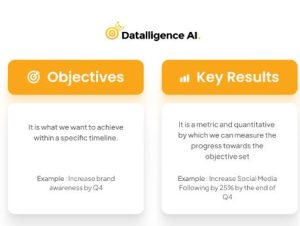What Is the Best Way to Write an OKR?
Objective and Key Results (OKRs) have emerged as a cornerstone for strategic planning in many successful companies, including industry giants like Google and Intel. When crafted well, OKRs can drive focus, unite teams around shared goals, and spark tremendous growth. Here’s how you can master the art of writing effective OKRs.

Start with a Clear, Inspiring Objective
The objective sets the tone: it should be ambitious yet achievable, designed to push your team but not be so lofty as to seem impossible. An effective objective should inspire and be clear enough that anyone in the organization can understand its purpose. For example, a SaaS company might aim to “Revolutionize customer engagement through our innovative software solutions.”
Define Precise, Quantifiable Key Results
Key Results should be specific metrics that mark progress towards the objective. They need to be measurable and time-bound. Instead of vague intentions like “improve sales,” opt for precise targets such as “Increase sales by 15% in Q2.” This specificity enables clear tracking and accountability.
Align OKRs with Company Vision
Alignment ensures that the OKRs support broader company goals and aren’t just isolated targets. When OKRs are aligned, resources and efforts are maximized, preventing departmental silos. For instance, if a company’s vision includes becoming the market leader, an OKR could focus on capturing a specific market share or entering new markets.
Keep It Simple and Focused
A common pitfall is setting too many OKRs at once, which can dilute focus and resources. Best practices suggest having no more than five key results per objective and ensuring they are not overlapping but rather complement each other. Simplicity in your OKRs makes them more understandable and actionable.
Involve Your Team
Involvement from the team in setting OKRs not only ensures that the goals are realistic but also boosts engagement as team members feel ownership of the outcomes. A collaborative approach in setting these goals can surface insights from different levels of the organization, leading to more robust and attainable OKRs.
Regularly Review and Adapt
The dynamic nature of business today means that what may be relevant at the beginning of a quarter might not be as pertinent by its end. Regular check-ins, at least once a month, help keep the team on track and allow for adjustments in response to changes in the business environment or market conditions. These reviews should focus on progress and hurdles in key results, leading to real-time solutions and recalibrations if necessary.
Embedding Flexibility and Agility
While it’s crucial to set ambitious goals, it’s equally important to maintain flexibility. The ability to adapt OKRs in response to new information or feedback ensures they remain relevant and continue to drive growth effectively. This dynamic adjustment is the hallmark of a responsive and resilient planning process.
For further insights on how to write OKR, you can explore detailed strategies and examples.
Drive and Determination: The Fuel for Effective OKRs
Ultimately, the success of OKRs depends heavily on the commitment and drive of the team. With clear goals, precise measures of success, and regular recalibration, OKRs transform from mere objectives into powerful catalysts for organizational achievement. Remember, the best OKRs inspire action, foster team cohesion, and drive measurable growth.